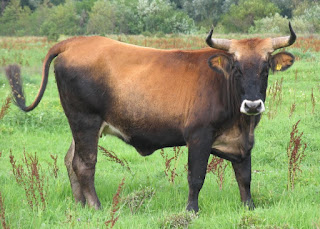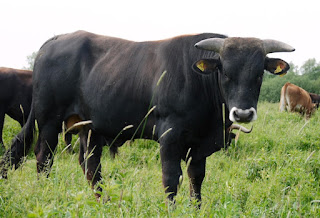I already
did a similar post in 2016. It was on old or removed Taurus cattle from the
Lippeaue herd in North-Rhine Westphalia, Germany. I used a photo archive and
stock list I was provided during my last visit in 2015 to pick out interesting
individuals and presented them in the blog post. I covered the herd a lot
already, but I found some more interesting individuals that I do not want to
keep from you. These cross products can be interesting in a number of ways:
either due to their breed combination, what they tell us about their parents or
simply because of their looks. I hope you enjoy. All photos are curtesy of Matthias Scharf from the ABU, so please do not replicate without permission.
84 025
This
nameless bull was the son of Luca (Heck x Chianina) and Loxia (Luca x
Sayaguesa). He looked a bit like a black version of his father-grandfather. His
correct colour made him very beautiful to look at, although the other traits
were not that convincing to me. He is being offered on the VFA’s sale page for
a long time now, so some of you might already know him, but is not present in the herd since 2013 at least.
84 037
This bull
has an interesting aspect. He is the son of Lombriz (50% Sayaguesa, 50% Heck x
Chianina) and Lerida (Heck x Sayaguesa). The legs seem a bit short, and the
spine is somewhat hanging (a trait that Sayaguesa often unfortunately have),
but the overall impression on me is appealing – there are, however, better
Lippeaue bulls and that is why it seemingly was removed.
92 576
This bull
is the son of Churro, the Sayaguesa bull, and Lerida. Despite being three
quarters, it has a reddish saddle, which is untypical for a bull with such a
high portion of Sayaguesa. The left horn seemingly got injured.
Lambretta
This cow is
the daughter of Lucio and Ludovica, thus (Heck x Sayaguesa) x (Heck x Chianina)
and had a quite good aspect – horn shape and size good, colour accurate, body
and proportions good. This cow seems just fine to me, but did not stay that
long in the herd. Perhaps her behaviour was undesirable.
Lisette
Lisette was
the daughter of Loco and Lerida, therefore was (Heck x Lidia) x (Heck x
Sayaguesa). Now this cow looked really, really good. Her horn curvature was
good, albeit a bit asymmetric, the face was elongated and colour and
proportions perfect. This the Taurus cow that in my view had the best body
shape of all, with a slender waist and a detectable hump (a trait that is
comparably rare even in less-derived cattle). She lived in Klostermersch-Süd
from 2005 to 2010 and left two descendants, of which none left a track in the
current population. This cow looked really good to me – if the horns would have
been a bit larger and more intensively curved, I would have been satisfied to
100% from the breeding perspective. However, she had some small white spots in
the sternal region and I do not know anything about her behaviour. Perhaps it
was problematic due to her quarter Lidia ancestry.
92 566
This bull
immediately got my interest – I must have overlooked it when I was looking for
individuals of that combination in the past. It was a Sayaguesa x Chianina bull
that stayed in the herd until the age of a bit more than two years (2010-2012).
It is very interesting to see a bull of that combination at this age, and also
perfectly wild type coloured with almost no saddle. This is the second bull of
this combination that I know of with a dark colour, while cows of this
combination tend to be of a beige colour (see here and here; there is one bull
that resulted in a very light grey colour for whatever reason), which might
indicate that Chianina has retained sexual dichromatism to a certain degree,
masked under the colour dilution factors.
Of course
the horns of this bull are very short, which is to b expected from this
combination. But it is not so much what this particular F1 bull looks like that
captures my enthusiasm about this combination, but the potential it bears if it
would have been mated to the two Sayaguesa x Chinina cows (here and here) in the Lippeaue. The
horn size probably would not end up spectacular, but anything else has the
potential to become rather astonishing: size, body shape/proportions, skull
shape, correct colour with dimorphism to some degree, and even horn curvature
has potential. That’s why I was very much looking forward to see the
Sayaguesa-Chianina cross herd planned by the Auerrindprojekt, which was not yet
put into practise due to the death of the bull Johnny.
Leonora
This cow
was the daughter of the Sayaguesa x Heck bull Lucio and the Chianina cow
Eloisa. I included her here because of her very slender, long-legged build and
the correct, non-diluted colour. It is interesting that some half-Chianina cows
and bulls are either completely wild type coloured, white/light grey or
something inbetween. Chianina is most likely always homozygous for the at least
two or maybe three colour dilution genes, so it is probably not the varying
factor. Perhaps it is the Heck cattle influence: the Heck parents may be carry
one or two of the dilution factors on occasion, in which case the offspring is
(partly) of a diluted colour then. The Heck bull Lancelot, for example, had a
quite diluted coat colour. Mator might also have passed on dilution alleles, as
some of its offspring and its Dutch origin suggests.
Leonora was
removed in 2007 or 2008, perhaps because of her meagre horns.
Lolaf
Lolaf was
the son of Pablo and Lila – Pablo is a beautiful but rather hefty Heck x
Sayaguesa bull, Lila is/was a cow with a quarter Lidia in her genealogy. So
this bull was one eighth Lidia, and I think it shows in its face and somehow
columnar trunk – yes, of course Lidia is probably the most athletically built
taurine breed, but aging bulls develop a rather heavy, columnar trunk.
Crossbred bulls, although being somewhat more muscular, have this columnar
trunk already at young age as far as I can tell from the photos.
Luke
Luke was
three quarters Heck, one quarter Lidia. He seemingly has at least one dilution
factor (either homozygous or heterozygous), and since both Lancelot and Mator
are his grandfathers it might not be that surprising.
84 562
This cow is
interesting because it is the daughter of Luca and a Tudanca cow that was kept
in the Hellinghauser Mersch herd for a short time. She has a grey diluted coat,
and the chance for her getting a diluted coat was quite high, as Tudanca is
homozygous for at least one kind of dilution, and Luca perhaps was too due to
him being half Lancelot and half Chianina.
This cow
seemingly was not kept for long and did not leave a track in the population.















Hi,
ReplyDeleteone question: why is the color soooo important?
That cows should not be white because it leads to more eye diseases, ok.
That some colors are a better targets for carnivores, especially as calves, ok.
That horns are important because they have a function, ok.
That size matters for ecological reasons, ok.
But a few spots, or a bit a diluted coat color, who cares?
The selection of a breed replacing (or re-taking) the aurochs place in the european ecosystems would be much faster if the 70% (wild guess) of the animals discarded for cosmetic reasons were assessed for the other traits, both behavioural and phenotypical
Future generations can still be selected for color later on if it is important for zoos to have "perfect" looking animals.
Do I miss something?
No herd discards "70%" or a majority of its animals. It is just that the Lippeaue does not have the space for more than 100 individuals, it should be somewhere between 80-100, so a certain number of individuals has to be removed each year. And when doing so, one can take the chance and select out animals with undesired traits.
DeleteIt is not that there is not enough cattle for the space of Europe's natural landscapes, actually it is more the other way round.